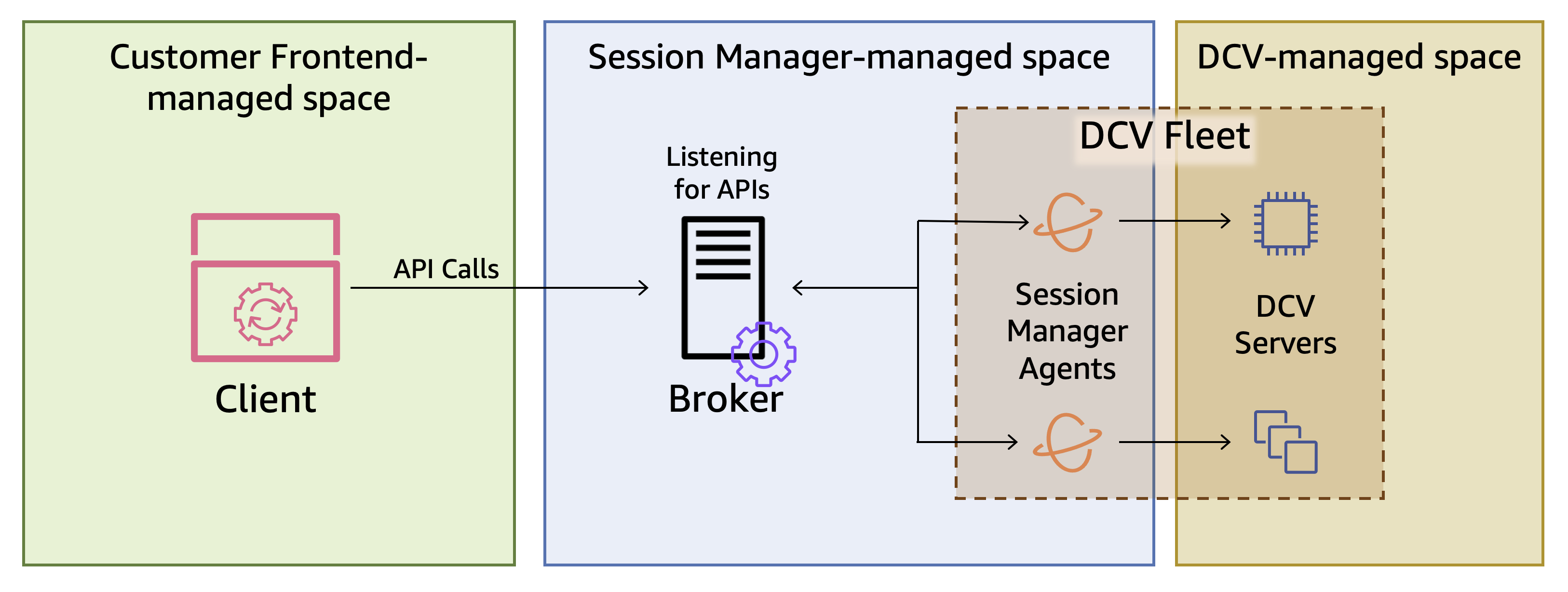What is Amazon DCV Session Manager?
Note
Amazon DCV was previously known as NICE DCV.
Amazon DCV Session Manager is set of installable software packages (an Agent and a Broker) and an application programming interface (API) that makes it easy for developers and independent software vendors (ISVs) to build front-end applications that programmatically create and manage the lifecycle of Amazon DCV sessions across a fleet of Amazon DCV servers.
This guide explains how to install and configure the Session Manager Agent and Broker. For more information about using the Session Manager APIs, see the Amazon DCV Session Manager Developer Guide.
How Session Manager works
The following diagram shows the high-level components of Session Manager.

- Broker
-
The Broker is a web server that hosts and exposes the Session Manager APIs. It receives and processes API requests to manage Amazon DCV sessions from the client, and then passes the instructions to the relevant Agents. The Broker must be installed on a host that is separate from your Amazon DCV servers, but it must be accessible to the client, and it must be able to access the Agents.
- Agent
-
The Agent is installed on each Amazon DCV server in the fleet. The Agents receive instructions from the Broker and run them on their respective Amazon DCV servers. The Agents also monitor the state of the Amazon DCV servers, and send periodic status updates back to the Broker.
- APIs
-
Session Manager exposes a set of REST application programming interfaces (APIs) that can be used to manage Amazon DCV sessions on a fleet of Amazon DCV servers. The APIs are hosted on and exposed by the Broker. Developers can build custom session management clients that call the APIs.
- Client
-
The client is the front-end application or portal that you develop to call the Session Manager APIs that are exposed by the Broker. End users use the client to manage the sessions hosted on the Amazon DCV servers in the fleet.
- Access token
-
In order to make an API request, you must provide an access token. Tokens can be requested from the Broker, or an external authorization server, by registered client APIs. To request and access token, the client API must provide valid credentials.
- Client API
-
The client API is generated from the Session Manager API definition YAML file, using Swagger Codegen. The client API is used to make API requests.
- Amazon DCV session
-
An Amazon DCV session is a span of time when the Amazon DCV server is able to accept connections from a client. Before your clients can connect to an Amazon DCV session, you must create an Amazon DCV session on the Amazon DCV server. Amazon DCV supports both console and virtual sessions, and each session has a specified owner and set of permissions. You use the Session Manager APIs to manage the lifecycle of Amazon DCV sessions. Amazon DCV sessions can be in one of the following states:
-
CREATING—the Broker is in the process of creating the session. -
READY—the session is ready to accept client connections. -
DELETING—the session is being deleted. -
DELETED—the session has been deleted. -
UNKNOWN—unable to determine the session's state. The Broker and the Agent might be unable to communicate.
-
Features
DCV Session Manager offers the following features:
-
Provides Amazon DCV session information—get information about the sessions running on multiple Amazon DCV servers.
-
Manage the lifecycle for multiple Amazon DCV sessions—create or delete multiple sessions for multiple users across multiple Amazon DCV servers with one API request.
-
Supports tags—use custom tags to target a group of Amazon DCV servers when creating sessions.
-
Manages permissions for multiple Amazon DCV sessions—modify user permissions for multiple sessions with one API request.
-
Provides connection information—retrieve client connection information for Amazon DCV sessions.
-
Supports for cloud and on-premises—use Session Manager on AWS, on-premises, or with alternative cloud-based servers.
Limitations
Session Manager does not provide resource provisioning capabilities. If you are running Amazon DCV on Amazon EC2 instances, you might need to use additional AWS services, such as Amazon EC2 Auto Scaling to manage the scaling of your infrastructure.
Pricing
Session Manager is available at no cost for AWS customers running EC2 instances.
On-premises customers require a Amazon DCV Plus or Amazon DCV Professional Plus license. For
information about how to purchase a Amazon DCV Plus or Amazon DCV Professional Plus license, see
How to Buy
For more information, see Licensing the Amazon DCV Server in the Amazon DCV Administrator Guide.